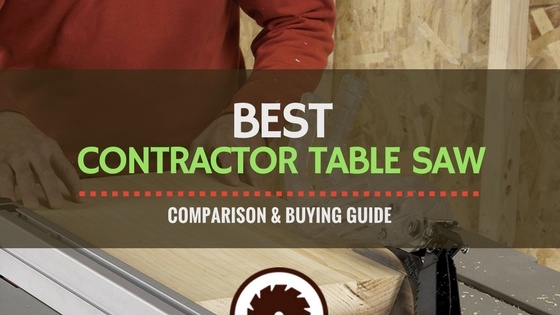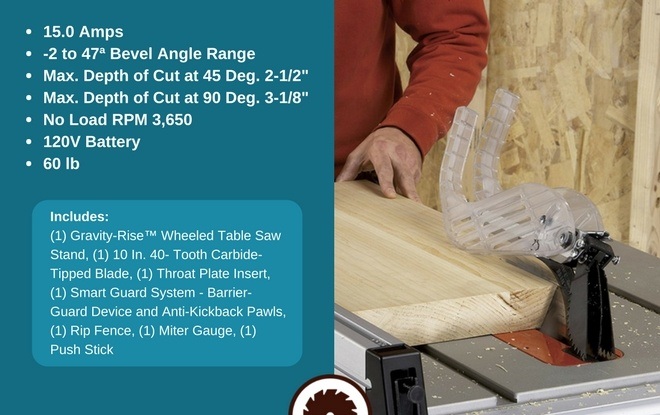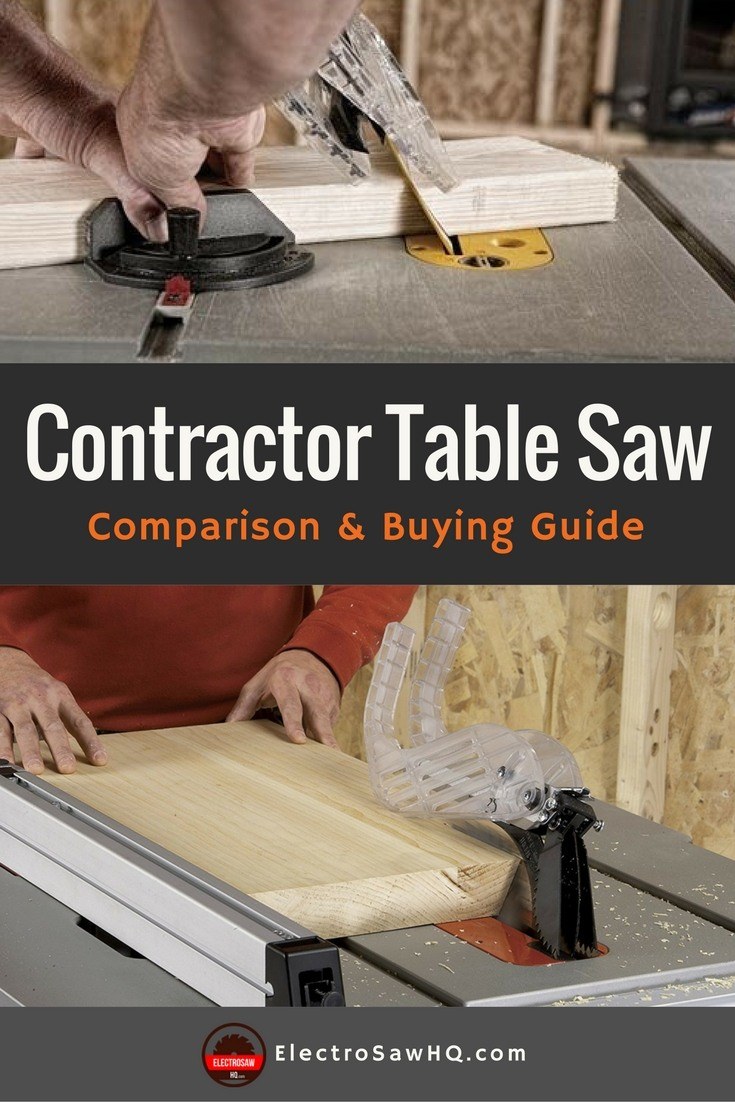
A Roundup of the Best Contractor Table Saw of 2019 Reviews
The term "contractor table saw" generally refers to a high-quality portable table saw. Some of the table saws on this list can be carried, and some can be rolled around. Getting the best contractor table saw of 2018 for your business will require careful review of where your construction needs to take place. Here’s the list of table saws we’ll review today:
Rating | Product |
|---|---|
 Best | |
   | |
   | |
   | |
   |
What is a Contractor Table Saw?
A contractor table saw is one that can run for hours, transports or at least moves easily without getting jostled out of alignment, and is flexible enough to be put to use in a variety of ways. For example, a saw that can use a stacked dado blade is critical for commercial joinery, a necessary method of construction when putting together everything from custom cabinets to roof rafters. Check out the following video for more on dado blades:
How to Choose the Best Contractor Table Saw of 2018
Where does the majority of your work get done? How much finish carpentry do you do? For finish carpentry work such as cabinetry, you're going to want a stable in-house contractor saw or perhaps the best cabinet table saw you can afford. In this instance, you want to keep the saw as stable as possible, avoid jostling it and just check the alignment on a maintenance basis. If this is you, be sure to check out our other reviews to find your right fit.
Are you building a custom deck or another outdoor project? Be sure to read up on a few portable table saw reviews to confirm that your chosen saw is not only well built, but that the casters are durable enough to handle rough terrain. You need a saw that can take a bit of jostling and still cut consistently. To use this saw for finish work, you'll probably have to do some maintenance and get things lined back up as noted in the video below.
Advantages of a Contractor Table Saw
Contractor saws are built with long days in mind. These saws can run for long stretches without getting warm or developing a wobble in the arbor.
In addition, while these saws will serve well as a benchtop table saw, a contractor table saw will have a durable rolling stand that can handle the mud of a job site and still setup even and level. Their stands offer transport, not just a spot to mount the saw.
Attributes to Consider
You want a saw with a metal top, not plastic. Additionally, your table saw should have easily accessible storage and at least a 24-inch ripping capacity. More than that is actually ideal; you can't rip down a 4 x 8 sheet of anything alone if the rip capacity is only 24 inches.
Usage Best Practices
Move your saw with care. Bouncing them around, whether you're rolling them around your shop or getting them out of a truck, will impact the accuracy of the saw. The blade is designed to sit at 90 degrees to the table, but a couple of bad bounces can change that.
Use the dust port consistently. A fine layer of dust on everything will make it hard to move the rails and thus difficult to line up your cuts. Keep things vacuumed and your saw will work more smoothly. Finally, read the instructions. Many contractor table saws require some assembly, and putting this together right will make all your cuts easier.
Prerequisites
Eye protection, ear protection, and a basic knowledge of the tool are critical. Learn to handle the push stick as you send narrow strips between the blade and the rip fence. Finally, take a good look at the miter guide.
If your miter guide is mostly made out of plastic and bends easily, consider replacing it with a metal one. The most solid saw in the world won't cut a good angle if your miter guide is bending as you work.
Best Contractor Table Saw of 2018 Options on the Market
The Bosch 4100-09 is built to travel, from storage bin to stand. There's a spot for everything you need to work this saw inside the storage bin and it locks down, so no loss or damage from bumping around.
This saw will fit a 13/16" dado stack up to an 8" blade. While the promotional video shows a digital fence guide, it's important to note that this saw doesn't come with the digital guide; it's been discontinued by the manufacturer but can still be purchased from other sources.



The stand for this saw is easy to use and works exactly as promoted; you pull the handle and the stand opens and settles easily into a flat work table at an easy height of 37.5 inches.



PROS
CONS
This well-built saw comes with its own sturdy stand and can be tipped on its side and rolled onto job sites. The stand features large durable casters that can travel across rough gravel and even be maneuvered down stair sets so you can cut exactly where the lumber is needed. In addition, the folding stand is narrow enough to pass through nearly any doorway.
The Dewalt 10" Jobsite Table Saw features telescoping rails for a wide deck that will extend up to 32.5 inches. The 15-amp motor gives you plenty of cutting power. A dado set is available for this saw, and there's onboard storage for your push stick and blade wrenches when not in use. There's a 2-inch dust collection port to keep down the mess.
When the stand is extended and the saw is ready to work, the deck height is 31" high. Once it's folded up for storage, it's only 48 inches tall, 21 inches deep and 26 inches wide.
PROS
CONS
The Makita 10-Inch saw has a rip capacity of up to 25 inches. This saw also features an electric brake to stop the saw when needed. There's storage built-in for extra blades, wrenches, safety guard and push stick. You can use a 13/16" dado blade with this saw.
The 15-amp motor delivers 4800 rpm for consistent cuts without bogging down. The top is die-cast aluminum for smoothness and easy movement of material across the deck. The rip fence locking system is extremely durable and accurate.
It's possible to purchase a stand built for this saw; once assembled, the working height is around 40 inches; short users may struggle to line things up safely.
PROS
CONS
While the previous saws in this listing could be lifted or moved by one user, this contractor saw is built to stay put. The Sawstop CNS175-TGP36 weighs in at over 340 pounds.
The Sawstop CNS175-TGP36 has a safety feature that oxffers great protection for you and your employees. There is an electrical monitoring system that enables the saw to tell the difference between flesh and wood, and this system applies a brake to the saw teeth at the moment of contact with flesh. This brake is applied within 1/200th of a second. Once this has been applied, it can be easily removed, but it will need to be replaced.
The blade will survive; the brake is designed to be destroyed. Portable saws go to the job site to make the assembly process easier; stand-based saws stay in one place and make the cutting process faster and more accurate. For cabinet makers and other custom cutters, this is an ideal saw.
PROS
CONS
This is not a saw to take to the job site; you'll want to bring the wood to this 322-pound saw. The Rikon 10-201 has 30-inch cast iron rails for a durable work surface and plenty of feeder space in front of the blade. The safety guide is clear, so lining up your work will be easy.
This 110 saw offers plenty of cutting power. It's easy to roll around the shop, but the size will make transport to the worksite impossible. The on and off buttons feature a unique configuration; turning the tool on requires a bit of looking, but the off button is a large flap that you can activate in a hurry if needed.
PROS
CONS
Conclusion
The winner of this contractor table saw comparison has to be the Bosch 4100-09. This saw will get to the worksite when you do and hang in there until the job is done. In addition to a powerful saw with great cutting power and durability, you get a stand that's easy to handle, easy to maneuver through tight doorways and sturdy.
Of course, each round of moving will jostle the saw and you'll need to review and true up the tool. However, for the investment, this saw will provide accurate cuts in any location.













